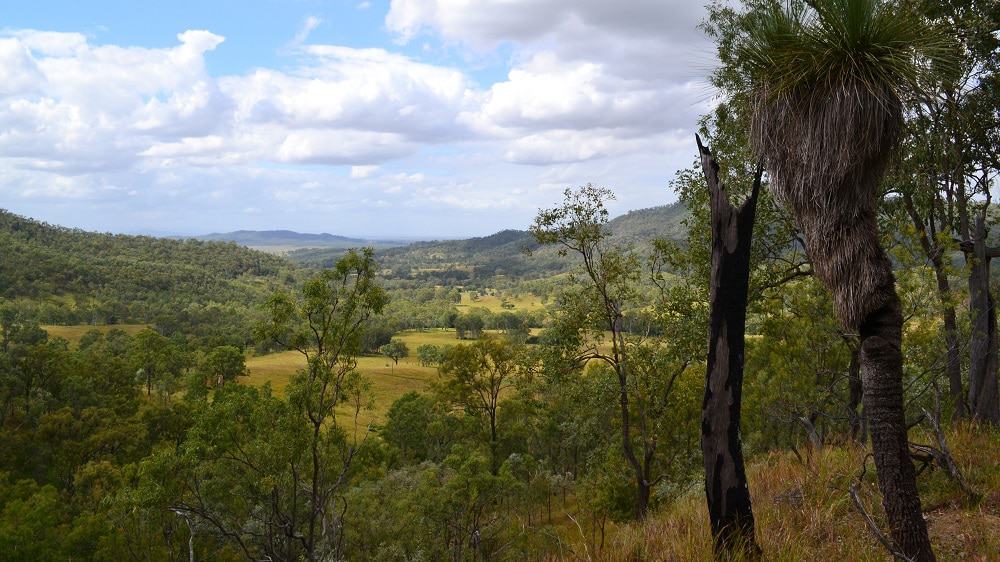A hike up the ridges of the Little Liverpool Range puts conservation into perspective.
Don’t just read about it – you also have a rare chance to see this for yourself.
The peaks of this little-known range on Ipswich’s far western boundary offer a spectacular view, and three clear reasons why the Little Liverpool Range is so important.
1. The Bigger Picture
Through the trees and the hills the expanse of three councils are visible – Ipswich, Lockyer Valley and Scenic Rim – with Brisbane twinkling on the horizon on a clear day.
Also clear are the nearby Main Ranges and Great Eastern Ranges. The Little Liverpool Range is itself a 51km spur off the Main Range, covering 46,000ha and containing a significant amount of remnant vegetation.
Standing high on the ridge brings the importance and challenge for the Little Liverpool Range into perspective – that this vital wildlife corridor can only exist with councils, landowners and a number of organisations working together.
That collaboration is underway, with the formation of the Little Liverpool Range Initiative to deliver cross-border conservation.
Members of the Initiative are not just preserving the Range – they are actively working to enhance the area and expand the remnant vegetation.
See it for yourself
The Little Liverpool Range Initiative will have a special event at QTFN’s Aroona property at Mount Mort on Saturday June 30, 12.30pm to 5pm.
The event will showcase how conservation and agriculture can coexist successfully, and how important collaboration is to the future of the Little Liverpool Range.
Part of the event will be a walk to the top of a ridge, which requires some physical fitness.
For more information and to RSVP email partnerships@ipswich.qld.gov.au
2. Wildlife refuge
As you trek up and down the ridge of the Little Liverpool Range it feels almost like time is standing still. Much about it remains unchanged and this region has largely escaped the pressures of urban development.
That’s what makes it an important wildlife refuge for native species, as the Little Liverpool Range provides essential habitat connectivity to the Main Ranges National Park and the Great Eastern Ranges.
It’s home to a number of significant species including glossy black cockatoo, powerful owl, brush-tailed rock wallaby, little pied bat and slender milk vine.
The habitat and various ecosystems within Little Liverpool Range are vital for the movement of native species, ensuring genetic diversity and long-term viability of populations.
In 1904 an intrepid climber scaled the Little Liverpool Range to feast their eyes on the “glorious panorama”.
So onward and upward we climb, zigzagging about, o’er stones and soil and clay, with deep dark gullies, ragged rocks, and steep cliffs on either side…
… It is still rough and tedious work, with just a spice of danger at times, as the only track in places is nothing but a wallaby path…
… We are now within the shadow of the peak, where we find the grass spangled with various bright-coloured flowers, and even at the hour of noon, still wet from the morning dew…
…Clinging to rocks, trees, grass, etc, we make our way upward…
…All this time we have been feasting our eyes on the glorious panorama which is spread out to our view…Down the centre of this valley, like a huge serpent in its windings, runs Laidley Creek…(at the north-eastern point) we sweep the horizon with the glass… while almost on the skyline Ipswich is seen, its iron roofs showing plainly in the sunlight….
Felicity and Thomas from Queensland Trust for Nature at Aroona, Mount Mort, with the Little Liverpool Range as a backdrop.
3. Combining cattle and conservation
At the base of the Little Liverpool Range is Aroona, a flagship property managed by Queensland Trust for Nature (QTFN).
The 2000ha Aroona has been a cattle farm form more than 50 years, but the property also has incredible ecological significance.
The aim is to have cattle co-exist with native flora and fauna, protecting threatened ecosystems and wildlife without locking up land.
This includes practices such as rotational grazing, fire management, and monitoring pasture for diversity of native grasses.
QTFN works with volunteers, the community, other landowners, and other groups at Aroona, and is part of Ipswich City Council’s Land for Wildlife partnership scheme.
One of the projects is to plant up the gully that will allow animals to travel from the ridge to the creekline.
This year 1500 trees were planted, a mix of koala-friendly species such as blue gum, iron bark and acacia – just one phase in this ongoing project that will span several years.

